Evidence-Based Report: Nurses' Pressure Ulcer Judgements & Decisions
VerifiedAdded on 2023/06/07
|13
|3258
|442
Report
AI Summary
This report critically appraises a systematic review focusing on nurses' judgments and decisions related to pressure ulcers in clinical practice. The review addresses the prevalence of pressure ulcers among hospitalized patients and the crucial role nurses play in prevention through risk assessment and patient repositioning. The systematic review aims to understand the impact of nurses' decision-making on patient outcomes and quality improvement. The review uses a PICO framework to guide the research questions, exploring how nurses make judgments in risk assessment, prevention, and management of pressure ulcers. The quality of the review is assessed based on eligibility criteria, information sources, data synthesis, and bias control. The results highlight nurses' reliance on clinical judgment over risk assessment tools, the influence of patient health status on prevention choices, and the limited use of decision trees. The report concludes by emphasizing the importance of rigorous methodology and evidence-based tools in systematic reviews to enhance their applicability in clinical practice. Desklib provides access to similar past papers and solved assignments for students.
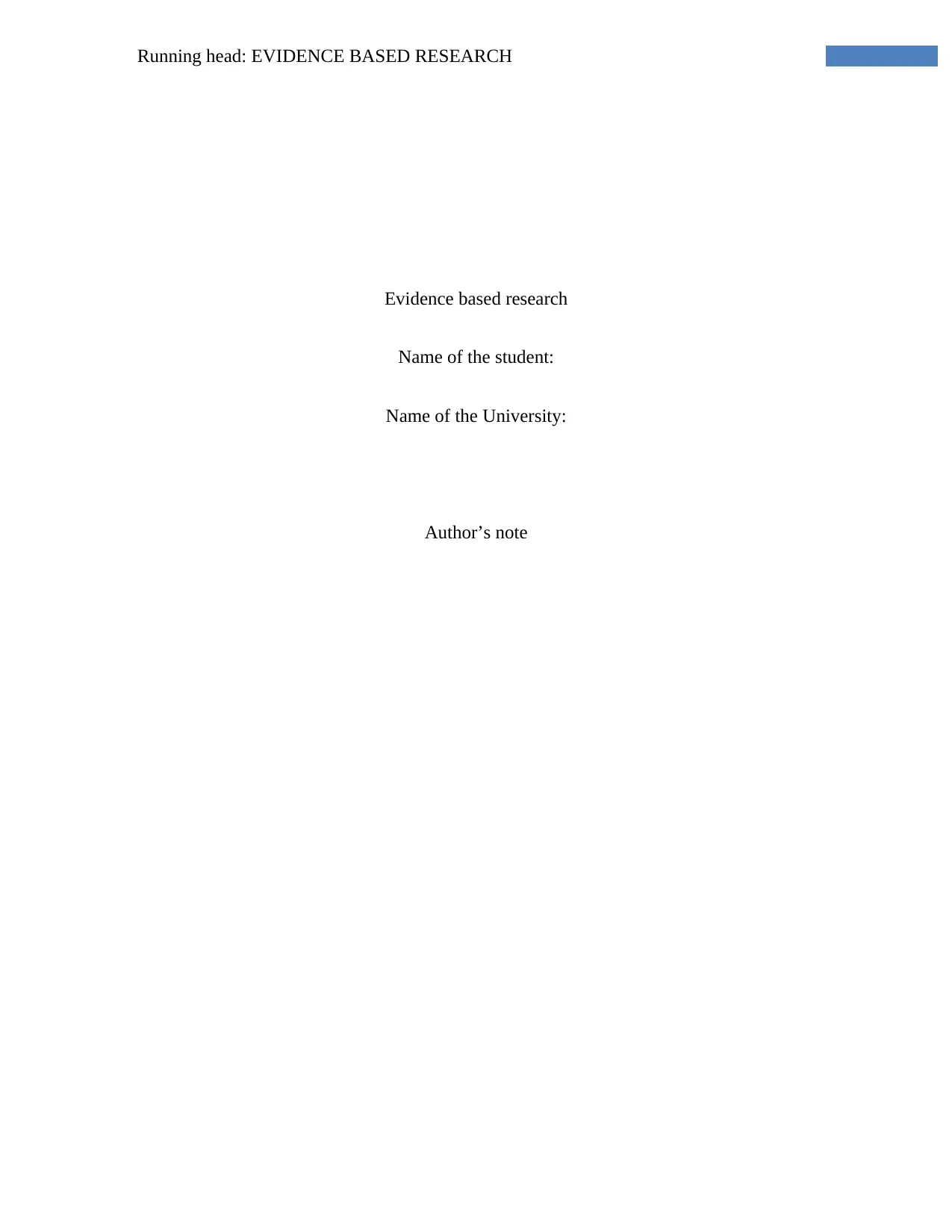
Running head: EVIDENCE BASED RESEARCH
Evidence based research
Name of the student:
Name of the University:
Author’s note
Evidence based research
Name of the student:
Name of the University:
Author’s note
Paraphrase This Document
Need a fresh take? Get an instant paraphrase of this document with our AI Paraphraser
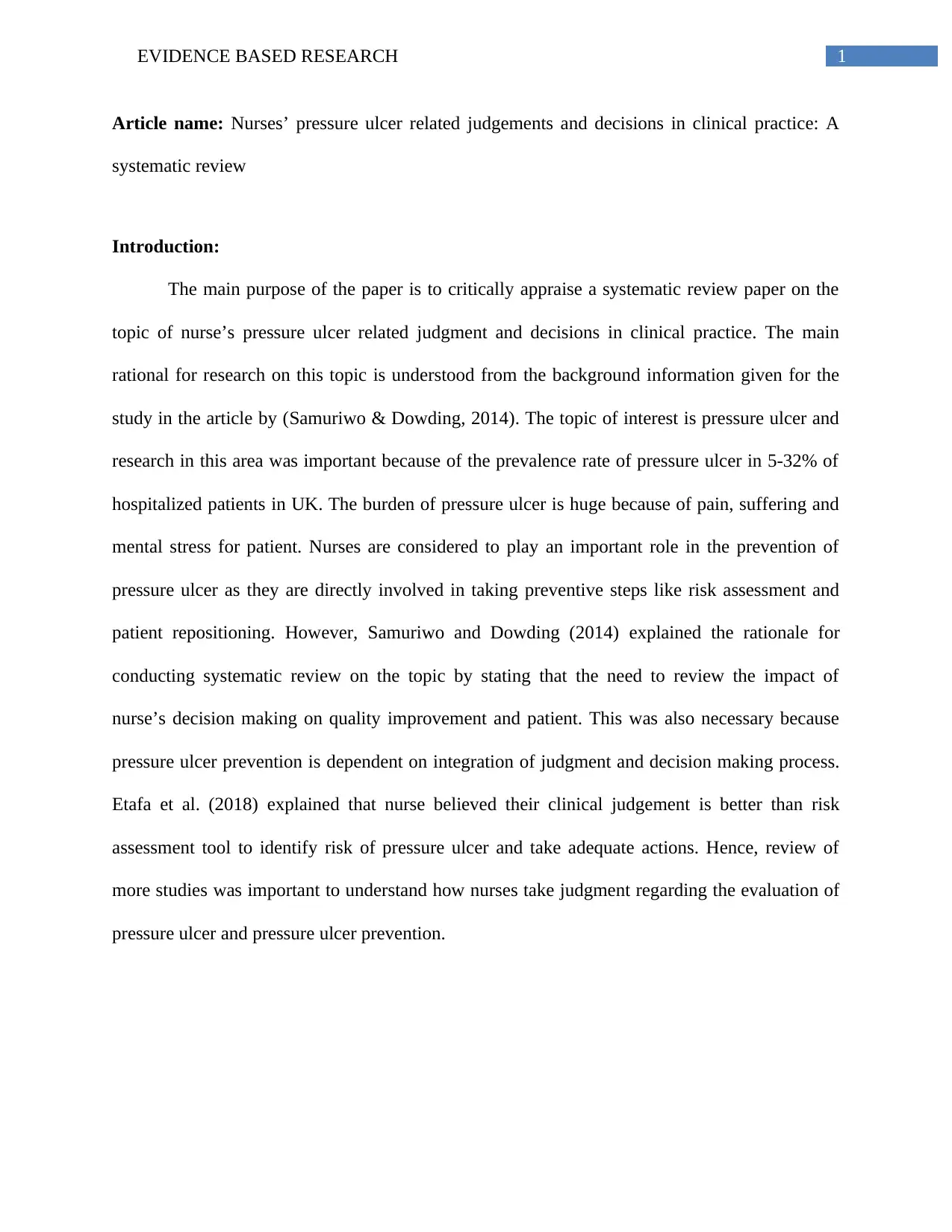
1EVIDENCE BASED RESEARCH
Article name: Nurses’ pressure ulcer related judgements and decisions in clinical practice: A
systematic review
Introduction:
The main purpose of the paper is to critically appraise a systematic review paper on the
topic of nurse’s pressure ulcer related judgment and decisions in clinical practice. The main
rational for research on this topic is understood from the background information given for the
study in the article by (Samuriwo & Dowding, 2014). The topic of interest is pressure ulcer and
research in this area was important because of the prevalence rate of pressure ulcer in 5-32% of
hospitalized patients in UK. The burden of pressure ulcer is huge because of pain, suffering and
mental stress for patient. Nurses are considered to play an important role in the prevention of
pressure ulcer as they are directly involved in taking preventive steps like risk assessment and
patient repositioning. However, Samuriwo and Dowding (2014) explained the rationale for
conducting systematic review on the topic by stating that the need to review the impact of
nurse’s decision making on quality improvement and patient. This was also necessary because
pressure ulcer prevention is dependent on integration of judgment and decision making process.
Etafa et al. (2018) explained that nurse believed their clinical judgement is better than risk
assessment tool to identify risk of pressure ulcer and take adequate actions. Hence, review of
more studies was important to understand how nurses take judgment regarding the evaluation of
pressure ulcer and pressure ulcer prevention.
Article name: Nurses’ pressure ulcer related judgements and decisions in clinical practice: A
systematic review
Introduction:
The main purpose of the paper is to critically appraise a systematic review paper on the
topic of nurse’s pressure ulcer related judgment and decisions in clinical practice. The main
rational for research on this topic is understood from the background information given for the
study in the article by (Samuriwo & Dowding, 2014). The topic of interest is pressure ulcer and
research in this area was important because of the prevalence rate of pressure ulcer in 5-32% of
hospitalized patients in UK. The burden of pressure ulcer is huge because of pain, suffering and
mental stress for patient. Nurses are considered to play an important role in the prevention of
pressure ulcer as they are directly involved in taking preventive steps like risk assessment and
patient repositioning. However, Samuriwo and Dowding (2014) explained the rationale for
conducting systematic review on the topic by stating that the need to review the impact of
nurse’s decision making on quality improvement and patient. This was also necessary because
pressure ulcer prevention is dependent on integration of judgment and decision making process.
Etafa et al. (2018) explained that nurse believed their clinical judgement is better than risk
assessment tool to identify risk of pressure ulcer and take adequate actions. Hence, review of
more studies was important to understand how nurses take judgment regarding the evaluation of
pressure ulcer and pressure ulcer prevention.
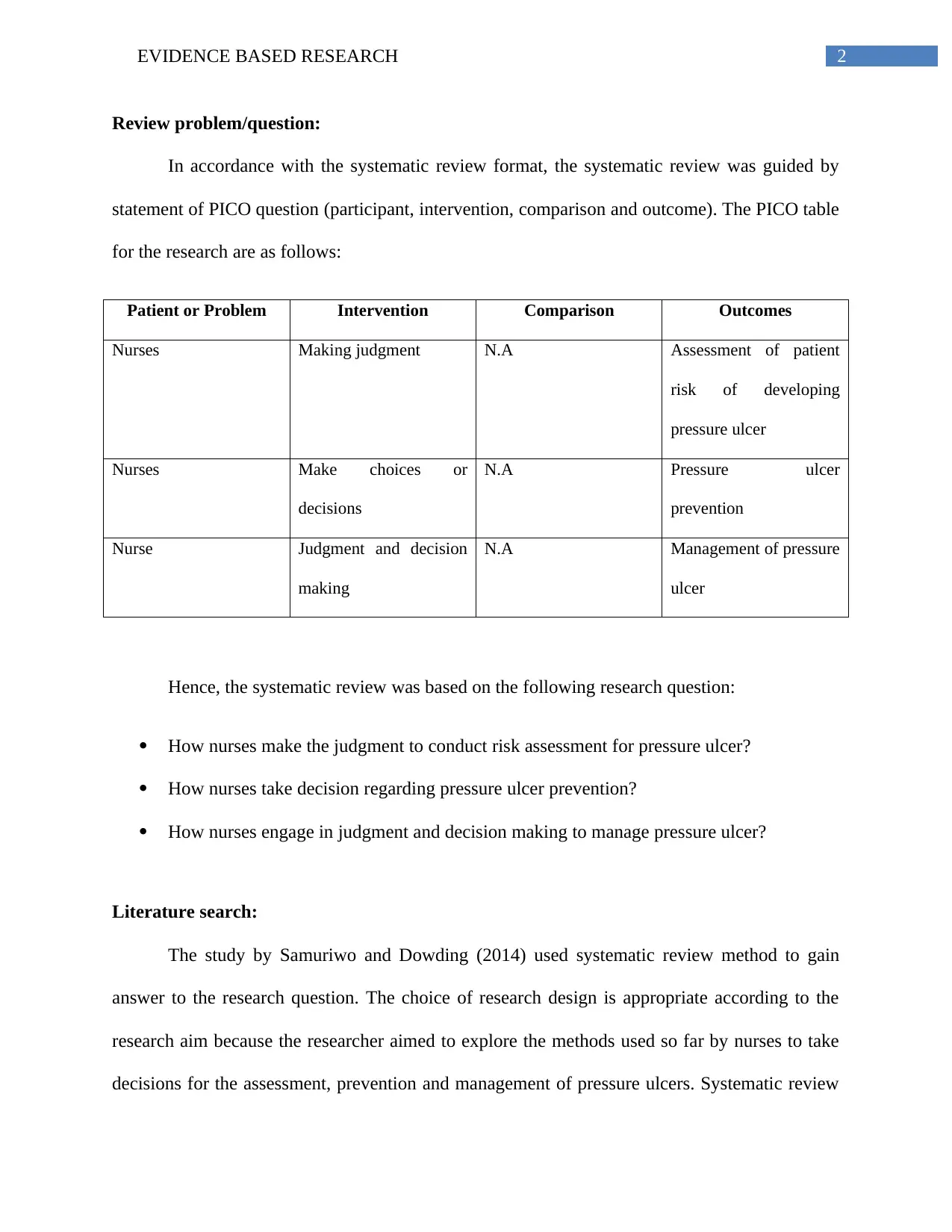
2EVIDENCE BASED RESEARCH
Review problem/question:
In accordance with the systematic review format, the systematic review was guided by
statement of PICO question (participant, intervention, comparison and outcome). The PICO table
for the research are as follows:
Patient or Problem Intervention Comparison Outcomes
Nurses Making judgment N.A Assessment of patient
risk of developing
pressure ulcer
Nurses Make choices or
decisions
N.A Pressure ulcer
prevention
Nurse Judgment and decision
making
N.A Management of pressure
ulcer
Hence, the systematic review was based on the following research question:
How nurses make the judgment to conduct risk assessment for pressure ulcer?
How nurses take decision regarding pressure ulcer prevention?
How nurses engage in judgment and decision making to manage pressure ulcer?
Literature search:
The study by Samuriwo and Dowding (2014) used systematic review method to gain
answer to the research question. The choice of research design is appropriate according to the
research aim because the researcher aimed to explore the methods used so far by nurses to take
decisions for the assessment, prevention and management of pressure ulcers. Systematic review
Review problem/question:
In accordance with the systematic review format, the systematic review was guided by
statement of PICO question (participant, intervention, comparison and outcome). The PICO table
for the research are as follows:
Patient or Problem Intervention Comparison Outcomes
Nurses Making judgment N.A Assessment of patient
risk of developing
pressure ulcer
Nurses Make choices or
decisions
N.A Pressure ulcer
prevention
Nurse Judgment and decision
making
N.A Management of pressure
ulcer
Hence, the systematic review was based on the following research question:
How nurses make the judgment to conduct risk assessment for pressure ulcer?
How nurses take decision regarding pressure ulcer prevention?
How nurses engage in judgment and decision making to manage pressure ulcer?
Literature search:
The study by Samuriwo and Dowding (2014) used systematic review method to gain
answer to the research question. The choice of research design is appropriate according to the
research aim because the researcher aimed to explore the methods used so far by nurses to take
decisions for the assessment, prevention and management of pressure ulcers. Systematic review
⊘ This is a preview!⊘
Do you want full access?
Subscribe today to unlock all pages.

Trusted by 1+ million students worldwide
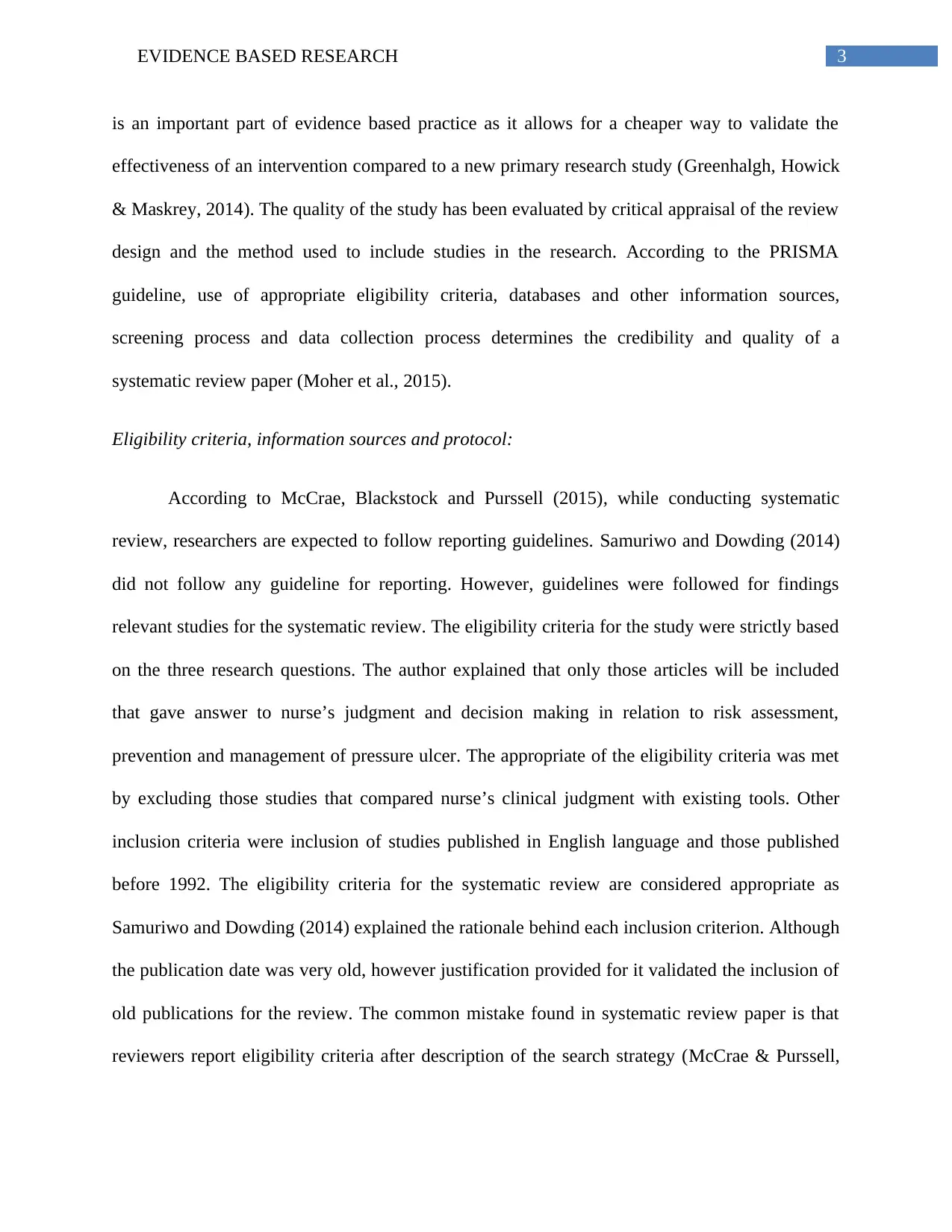
3EVIDENCE BASED RESEARCH
is an important part of evidence based practice as it allows for a cheaper way to validate the
effectiveness of an intervention compared to a new primary research study (Greenhalgh, Howick
& Maskrey, 2014). The quality of the study has been evaluated by critical appraisal of the review
design and the method used to include studies in the research. According to the PRISMA
guideline, use of appropriate eligibility criteria, databases and other information sources,
screening process and data collection process determines the credibility and quality of a
systematic review paper (Moher et al., 2015).
Eligibility criteria, information sources and protocol:
According to McCrae, Blackstock and Purssell (2015), while conducting systematic
review, researchers are expected to follow reporting guidelines. Samuriwo and Dowding (2014)
did not follow any guideline for reporting. However, guidelines were followed for findings
relevant studies for the systematic review. The eligibility criteria for the study were strictly based
on the three research questions. The author explained that only those articles will be included
that gave answer to nurse’s judgment and decision making in relation to risk assessment,
prevention and management of pressure ulcer. The appropriate of the eligibility criteria was met
by excluding those studies that compared nurse’s clinical judgment with existing tools. Other
inclusion criteria were inclusion of studies published in English language and those published
before 1992. The eligibility criteria for the systematic review are considered appropriate as
Samuriwo and Dowding (2014) explained the rationale behind each inclusion criterion. Although
the publication date was very old, however justification provided for it validated the inclusion of
old publications for the review. The common mistake found in systematic review paper is that
reviewers report eligibility criteria after description of the search strategy (McCrae & Purssell,
is an important part of evidence based practice as it allows for a cheaper way to validate the
effectiveness of an intervention compared to a new primary research study (Greenhalgh, Howick
& Maskrey, 2014). The quality of the study has been evaluated by critical appraisal of the review
design and the method used to include studies in the research. According to the PRISMA
guideline, use of appropriate eligibility criteria, databases and other information sources,
screening process and data collection process determines the credibility and quality of a
systematic review paper (Moher et al., 2015).
Eligibility criteria, information sources and protocol:
According to McCrae, Blackstock and Purssell (2015), while conducting systematic
review, researchers are expected to follow reporting guidelines. Samuriwo and Dowding (2014)
did not follow any guideline for reporting. However, guidelines were followed for findings
relevant studies for the systematic review. The eligibility criteria for the study were strictly based
on the three research questions. The author explained that only those articles will be included
that gave answer to nurse’s judgment and decision making in relation to risk assessment,
prevention and management of pressure ulcer. The appropriate of the eligibility criteria was met
by excluding those studies that compared nurse’s clinical judgment with existing tools. Other
inclusion criteria were inclusion of studies published in English language and those published
before 1992. The eligibility criteria for the systematic review are considered appropriate as
Samuriwo and Dowding (2014) explained the rationale behind each inclusion criterion. Although
the publication date was very old, however justification provided for it validated the inclusion of
old publications for the review. The common mistake found in systematic review paper is that
reviewers report eligibility criteria after description of the search strategy (McCrae & Purssell,
Paraphrase This Document
Need a fresh take? Get an instant paraphrase of this document with our AI Paraphraser
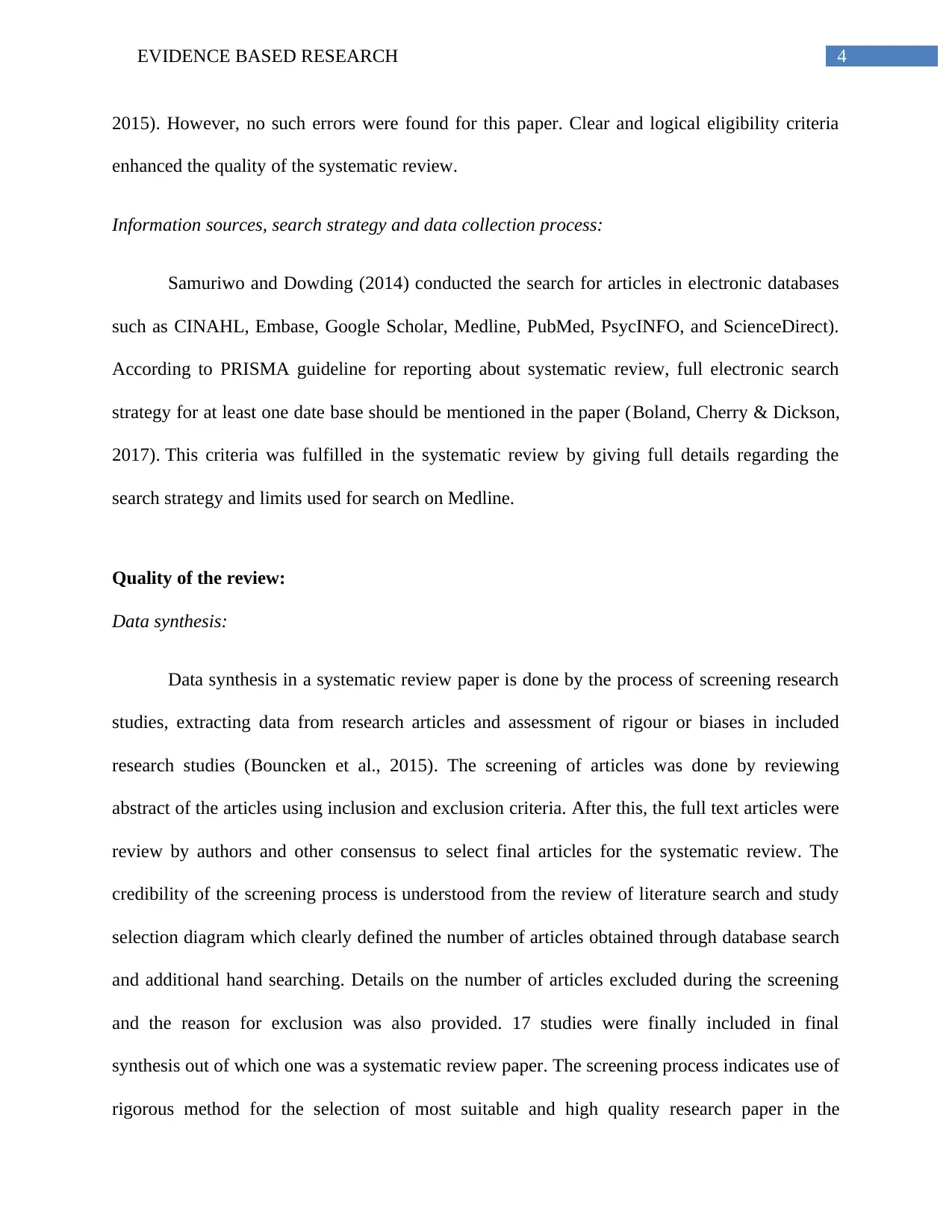
4EVIDENCE BASED RESEARCH
2015). However, no such errors were found for this paper. Clear and logical eligibility criteria
enhanced the quality of the systematic review.
Information sources, search strategy and data collection process:
Samuriwo and Dowding (2014) conducted the search for articles in electronic databases
such as CINAHL, Embase, Google Scholar, Medline, PubMed, PsycINFO, and ScienceDirect).
According to PRISMA guideline for reporting about systematic review, full electronic search
strategy for at least one date base should be mentioned in the paper (Boland, Cherry & Dickson,
2017). This criteria was fulfilled in the systematic review by giving full details regarding the
search strategy and limits used for search on Medline.
Quality of the review:
Data synthesis:
Data synthesis in a systematic review paper is done by the process of screening research
studies, extracting data from research articles and assessment of rigour or biases in included
research studies (Bouncken et al., 2015). The screening of articles was done by reviewing
abstract of the articles using inclusion and exclusion criteria. After this, the full text articles were
review by authors and other consensus to select final articles for the systematic review. The
credibility of the screening process is understood from the review of literature search and study
selection diagram which clearly defined the number of articles obtained through database search
and additional hand searching. Details on the number of articles excluded during the screening
and the reason for exclusion was also provided. 17 studies were finally included in final
synthesis out of which one was a systematic review paper. The screening process indicates use of
rigorous method for the selection of most suitable and high quality research paper in the
2015). However, no such errors were found for this paper. Clear and logical eligibility criteria
enhanced the quality of the systematic review.
Information sources, search strategy and data collection process:
Samuriwo and Dowding (2014) conducted the search for articles in electronic databases
such as CINAHL, Embase, Google Scholar, Medline, PubMed, PsycINFO, and ScienceDirect).
According to PRISMA guideline for reporting about systematic review, full electronic search
strategy for at least one date base should be mentioned in the paper (Boland, Cherry & Dickson,
2017). This criteria was fulfilled in the systematic review by giving full details regarding the
search strategy and limits used for search on Medline.
Quality of the review:
Data synthesis:
Data synthesis in a systematic review paper is done by the process of screening research
studies, extracting data from research articles and assessment of rigour or biases in included
research studies (Bouncken et al., 2015). The screening of articles was done by reviewing
abstract of the articles using inclusion and exclusion criteria. After this, the full text articles were
review by authors and other consensus to select final articles for the systematic review. The
credibility of the screening process is understood from the review of literature search and study
selection diagram which clearly defined the number of articles obtained through database search
and additional hand searching. Details on the number of articles excluded during the screening
and the reason for exclusion was also provided. 17 studies were finally included in final
synthesis out of which one was a systematic review paper. The screening process indicates use of
rigorous method for the selection of most suitable and high quality research paper in the
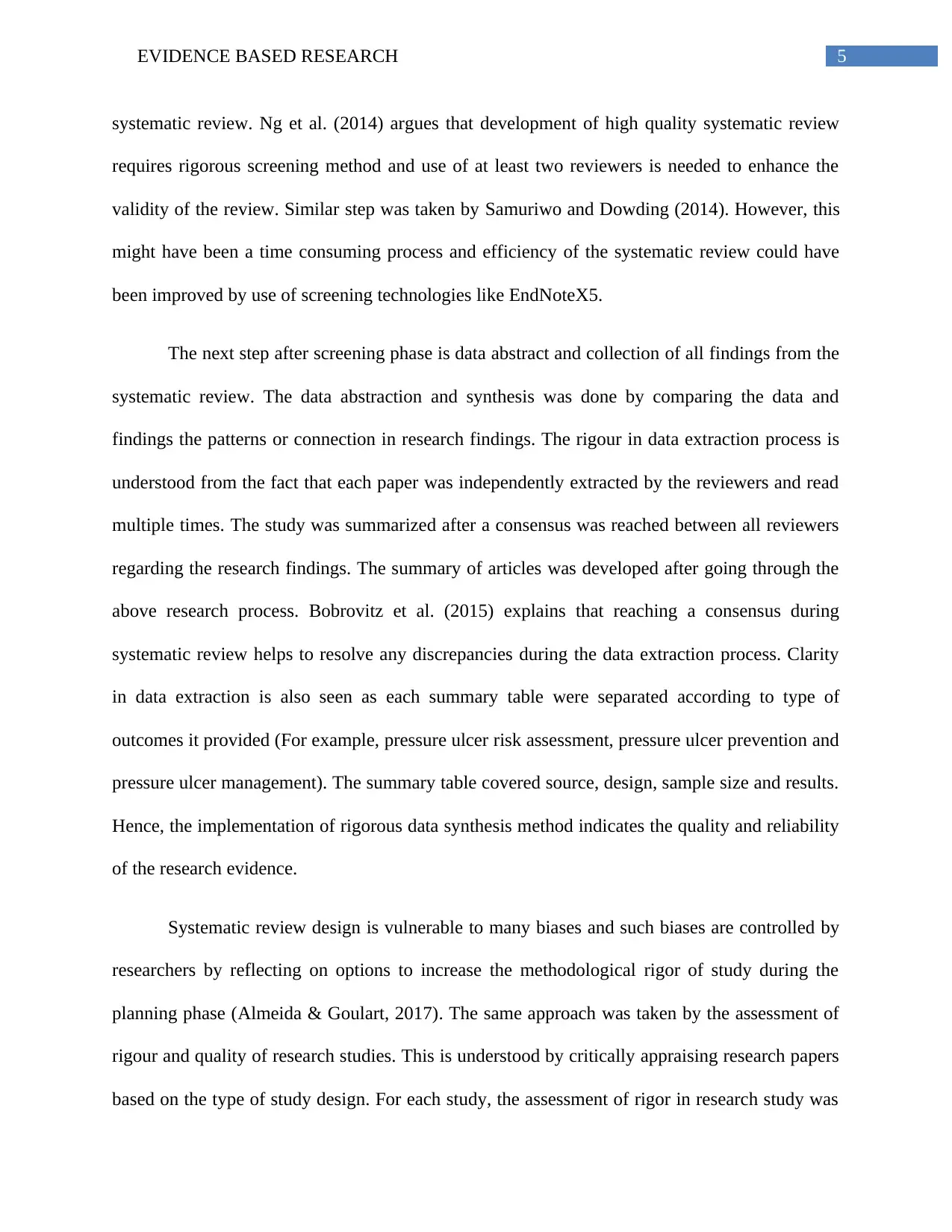
5EVIDENCE BASED RESEARCH
systematic review. Ng et al. (2014) argues that development of high quality systematic review
requires rigorous screening method and use of at least two reviewers is needed to enhance the
validity of the review. Similar step was taken by Samuriwo and Dowding (2014). However, this
might have been a time consuming process and efficiency of the systematic review could have
been improved by use of screening technologies like EndNoteX5.
The next step after screening phase is data abstract and collection of all findings from the
systematic review. The data abstraction and synthesis was done by comparing the data and
findings the patterns or connection in research findings. The rigour in data extraction process is
understood from the fact that each paper was independently extracted by the reviewers and read
multiple times. The study was summarized after a consensus was reached between all reviewers
regarding the research findings. The summary of articles was developed after going through the
above research process. Bobrovitz et al. (2015) explains that reaching a consensus during
systematic review helps to resolve any discrepancies during the data extraction process. Clarity
in data extraction is also seen as each summary table were separated according to type of
outcomes it provided (For example, pressure ulcer risk assessment, pressure ulcer prevention and
pressure ulcer management). The summary table covered source, design, sample size and results.
Hence, the implementation of rigorous data synthesis method indicates the quality and reliability
of the research evidence.
Systematic review design is vulnerable to many biases and such biases are controlled by
researchers by reflecting on options to increase the methodological rigor of study during the
planning phase (Almeida & Goulart, 2017). The same approach was taken by the assessment of
rigour and quality of research studies. This is understood by critically appraising research papers
based on the type of study design. For each study, the assessment of rigor in research study was
systematic review. Ng et al. (2014) argues that development of high quality systematic review
requires rigorous screening method and use of at least two reviewers is needed to enhance the
validity of the review. Similar step was taken by Samuriwo and Dowding (2014). However, this
might have been a time consuming process and efficiency of the systematic review could have
been improved by use of screening technologies like EndNoteX5.
The next step after screening phase is data abstract and collection of all findings from the
systematic review. The data abstraction and synthesis was done by comparing the data and
findings the patterns or connection in research findings. The rigour in data extraction process is
understood from the fact that each paper was independently extracted by the reviewers and read
multiple times. The study was summarized after a consensus was reached between all reviewers
regarding the research findings. The summary of articles was developed after going through the
above research process. Bobrovitz et al. (2015) explains that reaching a consensus during
systematic review helps to resolve any discrepancies during the data extraction process. Clarity
in data extraction is also seen as each summary table were separated according to type of
outcomes it provided (For example, pressure ulcer risk assessment, pressure ulcer prevention and
pressure ulcer management). The summary table covered source, design, sample size and results.
Hence, the implementation of rigorous data synthesis method indicates the quality and reliability
of the research evidence.
Systematic review design is vulnerable to many biases and such biases are controlled by
researchers by reflecting on options to increase the methodological rigor of study during the
planning phase (Almeida & Goulart, 2017). The same approach was taken by the assessment of
rigour and quality of research studies. This is understood by critically appraising research papers
based on the type of study design. For each study, the assessment of rigor in research study was
⊘ This is a preview!⊘
Do you want full access?
Subscribe today to unlock all pages.

Trusted by 1+ million students worldwide
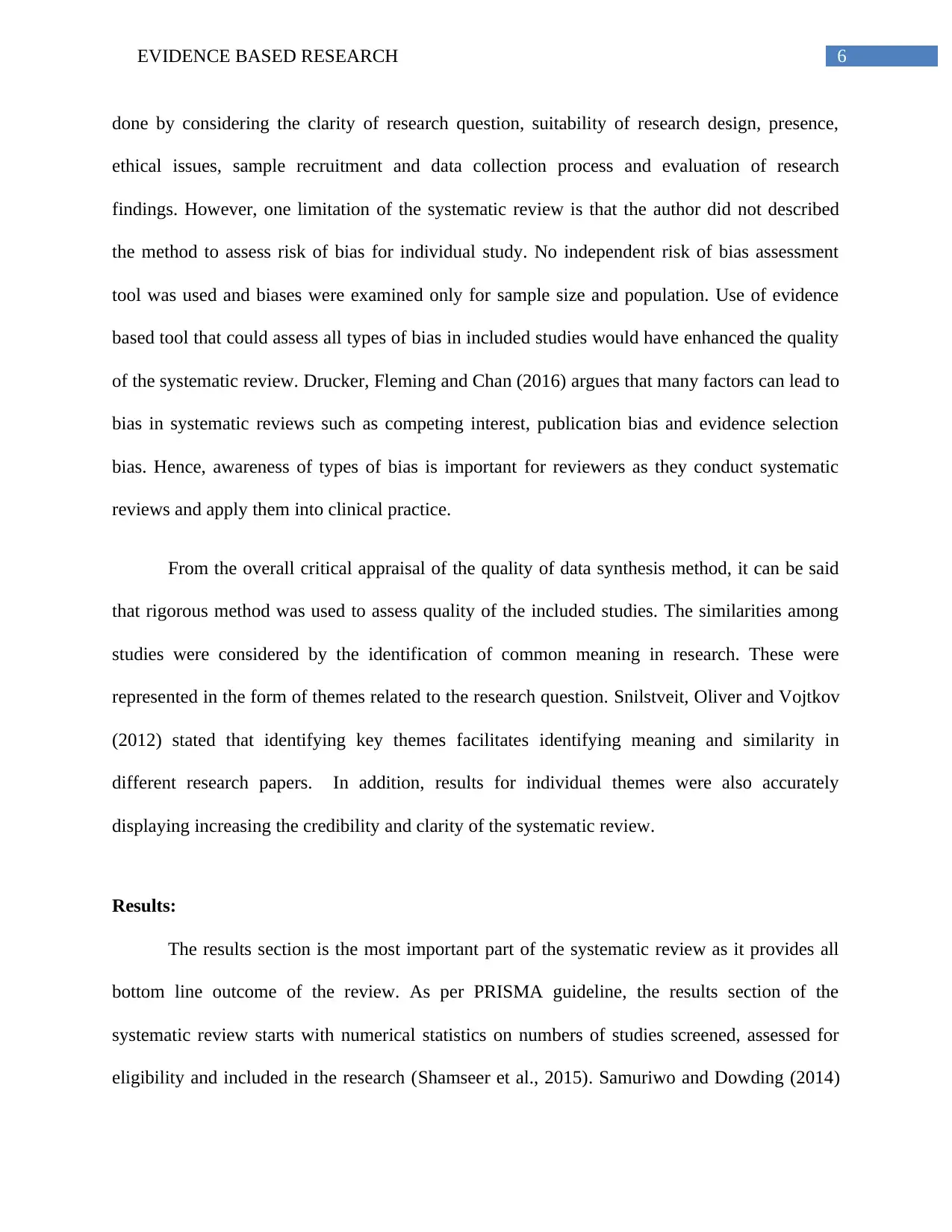
6EVIDENCE BASED RESEARCH
done by considering the clarity of research question, suitability of research design, presence,
ethical issues, sample recruitment and data collection process and evaluation of research
findings. However, one limitation of the systematic review is that the author did not described
the method to assess risk of bias for individual study. No independent risk of bias assessment
tool was used and biases were examined only for sample size and population. Use of evidence
based tool that could assess all types of bias in included studies would have enhanced the quality
of the systematic review. Drucker, Fleming and Chan (2016) argues that many factors can lead to
bias in systematic reviews such as competing interest, publication bias and evidence selection
bias. Hence, awareness of types of bias is important for reviewers as they conduct systematic
reviews and apply them into clinical practice.
From the overall critical appraisal of the quality of data synthesis method, it can be said
that rigorous method was used to assess quality of the included studies. The similarities among
studies were considered by the identification of common meaning in research. These were
represented in the form of themes related to the research question. Snilstveit, Oliver and Vojtkov
(2012) stated that identifying key themes facilitates identifying meaning and similarity in
different research papers. In addition, results for individual themes were also accurately
displaying increasing the credibility and clarity of the systematic review.
Results:
The results section is the most important part of the systematic review as it provides all
bottom line outcome of the review. As per PRISMA guideline, the results section of the
systematic review starts with numerical statistics on numbers of studies screened, assessed for
eligibility and included in the research (Shamseer et al., 2015). Samuriwo and Dowding (2014)
done by considering the clarity of research question, suitability of research design, presence,
ethical issues, sample recruitment and data collection process and evaluation of research
findings. However, one limitation of the systematic review is that the author did not described
the method to assess risk of bias for individual study. No independent risk of bias assessment
tool was used and biases were examined only for sample size and population. Use of evidence
based tool that could assess all types of bias in included studies would have enhanced the quality
of the systematic review. Drucker, Fleming and Chan (2016) argues that many factors can lead to
bias in systematic reviews such as competing interest, publication bias and evidence selection
bias. Hence, awareness of types of bias is important for reviewers as they conduct systematic
reviews and apply them into clinical practice.
From the overall critical appraisal of the quality of data synthesis method, it can be said
that rigorous method was used to assess quality of the included studies. The similarities among
studies were considered by the identification of common meaning in research. These were
represented in the form of themes related to the research question. Snilstveit, Oliver and Vojtkov
(2012) stated that identifying key themes facilitates identifying meaning and similarity in
different research papers. In addition, results for individual themes were also accurately
displaying increasing the credibility and clarity of the systematic review.
Results:
The results section is the most important part of the systematic review as it provides all
bottom line outcome of the review. As per PRISMA guideline, the results section of the
systematic review starts with numerical statistics on numbers of studies screened, assessed for
eligibility and included in the research (Shamseer et al., 2015). Samuriwo and Dowding (2014)
Paraphrase This Document
Need a fresh take? Get an instant paraphrase of this document with our AI Paraphraser
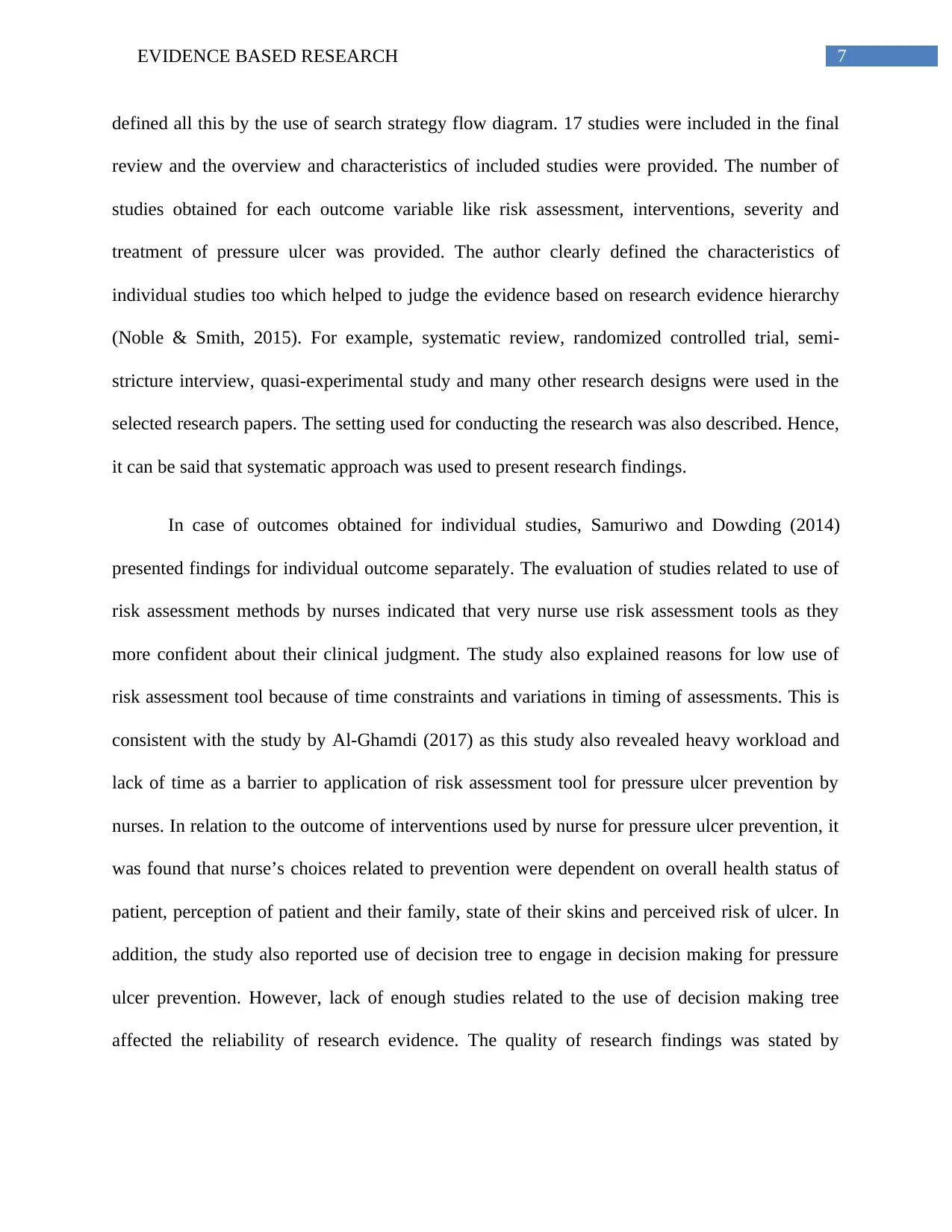
7EVIDENCE BASED RESEARCH
defined all this by the use of search strategy flow diagram. 17 studies were included in the final
review and the overview and characteristics of included studies were provided. The number of
studies obtained for each outcome variable like risk assessment, interventions, severity and
treatment of pressure ulcer was provided. The author clearly defined the characteristics of
individual studies too which helped to judge the evidence based on research evidence hierarchy
(Noble & Smith, 2015). For example, systematic review, randomized controlled trial, semi-
stricture interview, quasi-experimental study and many other research designs were used in the
selected research papers. The setting used for conducting the research was also described. Hence,
it can be said that systematic approach was used to present research findings.
In case of outcomes obtained for individual studies, Samuriwo and Dowding (2014)
presented findings for individual outcome separately. The evaluation of studies related to use of
risk assessment methods by nurses indicated that very nurse use risk assessment tools as they
more confident about their clinical judgment. The study also explained reasons for low use of
risk assessment tool because of time constraints and variations in timing of assessments. This is
consistent with the study by Al-Ghamdi (2017) as this study also revealed heavy workload and
lack of time as a barrier to application of risk assessment tool for pressure ulcer prevention by
nurses. In relation to the outcome of interventions used by nurse for pressure ulcer prevention, it
was found that nurse’s choices related to prevention were dependent on overall health status of
patient, perception of patient and their family, state of their skins and perceived risk of ulcer. In
addition, the study also reported use of decision tree to engage in decision making for pressure
ulcer prevention. However, lack of enough studies related to the use of decision making tree
affected the reliability of research evidence. The quality of research findings was stated by
defined all this by the use of search strategy flow diagram. 17 studies were included in the final
review and the overview and characteristics of included studies were provided. The number of
studies obtained for each outcome variable like risk assessment, interventions, severity and
treatment of pressure ulcer was provided. The author clearly defined the characteristics of
individual studies too which helped to judge the evidence based on research evidence hierarchy
(Noble & Smith, 2015). For example, systematic review, randomized controlled trial, semi-
stricture interview, quasi-experimental study and many other research designs were used in the
selected research papers. The setting used for conducting the research was also described. Hence,
it can be said that systematic approach was used to present research findings.
In case of outcomes obtained for individual studies, Samuriwo and Dowding (2014)
presented findings for individual outcome separately. The evaluation of studies related to use of
risk assessment methods by nurses indicated that very nurse use risk assessment tools as they
more confident about their clinical judgment. The study also explained reasons for low use of
risk assessment tool because of time constraints and variations in timing of assessments. This is
consistent with the study by Al-Ghamdi (2017) as this study also revealed heavy workload and
lack of time as a barrier to application of risk assessment tool for pressure ulcer prevention by
nurses. In relation to the outcome of interventions used by nurse for pressure ulcer prevention, it
was found that nurse’s choices related to prevention were dependent on overall health status of
patient, perception of patient and their family, state of their skins and perceived risk of ulcer. In
addition, the study also reported use of decision tree to engage in decision making for pressure
ulcer prevention. However, lack of enough studies related to the use of decision making tree
affected the reliability of research evidence. The quality of research findings was stated by
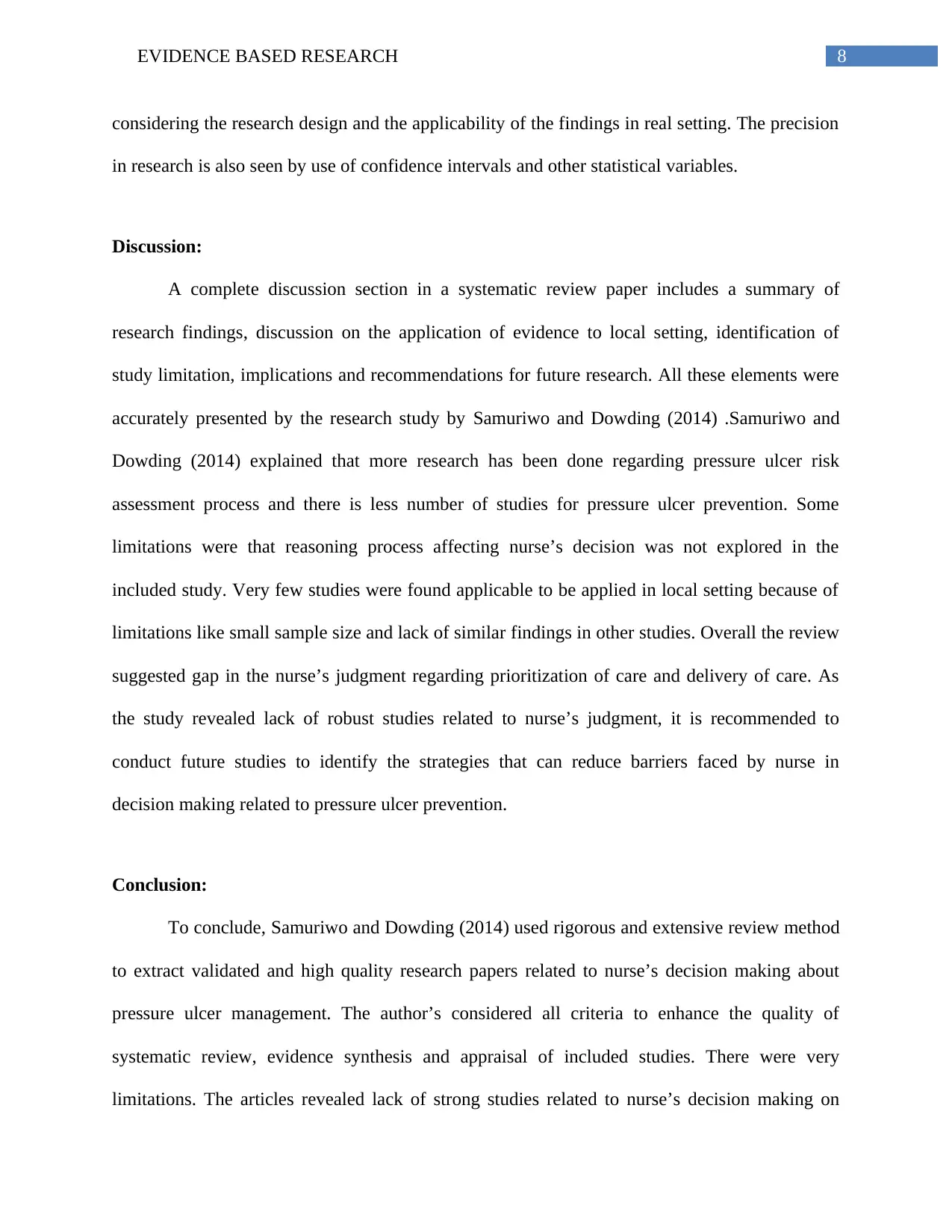
8EVIDENCE BASED RESEARCH
considering the research design and the applicability of the findings in real setting. The precision
in research is also seen by use of confidence intervals and other statistical variables.
Discussion:
A complete discussion section in a systematic review paper includes a summary of
research findings, discussion on the application of evidence to local setting, identification of
study limitation, implications and recommendations for future research. All these elements were
accurately presented by the research study by Samuriwo and Dowding (2014) .Samuriwo and
Dowding (2014) explained that more research has been done regarding pressure ulcer risk
assessment process and there is less number of studies for pressure ulcer prevention. Some
limitations were that reasoning process affecting nurse’s decision was not explored in the
included study. Very few studies were found applicable to be applied in local setting because of
limitations like small sample size and lack of similar findings in other studies. Overall the review
suggested gap in the nurse’s judgment regarding prioritization of care and delivery of care. As
the study revealed lack of robust studies related to nurse’s judgment, it is recommended to
conduct future studies to identify the strategies that can reduce barriers faced by nurse in
decision making related to pressure ulcer prevention.
Conclusion:
To conclude, Samuriwo and Dowding (2014) used rigorous and extensive review method
to extract validated and high quality research papers related to nurse’s decision making about
pressure ulcer management. The author’s considered all criteria to enhance the quality of
systematic review, evidence synthesis and appraisal of included studies. There were very
limitations. The articles revealed lack of strong studies related to nurse’s decision making on
considering the research design and the applicability of the findings in real setting. The precision
in research is also seen by use of confidence intervals and other statistical variables.
Discussion:
A complete discussion section in a systematic review paper includes a summary of
research findings, discussion on the application of evidence to local setting, identification of
study limitation, implications and recommendations for future research. All these elements were
accurately presented by the research study by Samuriwo and Dowding (2014) .Samuriwo and
Dowding (2014) explained that more research has been done regarding pressure ulcer risk
assessment process and there is less number of studies for pressure ulcer prevention. Some
limitations were that reasoning process affecting nurse’s decision was not explored in the
included study. Very few studies were found applicable to be applied in local setting because of
limitations like small sample size and lack of similar findings in other studies. Overall the review
suggested gap in the nurse’s judgment regarding prioritization of care and delivery of care. As
the study revealed lack of robust studies related to nurse’s judgment, it is recommended to
conduct future studies to identify the strategies that can reduce barriers faced by nurse in
decision making related to pressure ulcer prevention.
Conclusion:
To conclude, Samuriwo and Dowding (2014) used rigorous and extensive review method
to extract validated and high quality research papers related to nurse’s decision making about
pressure ulcer management. The author’s considered all criteria to enhance the quality of
systematic review, evidence synthesis and appraisal of included studies. There were very
limitations. The articles revealed lack of strong studies related to nurse’s decision making on
⊘ This is a preview!⊘
Do you want full access?
Subscribe today to unlock all pages.

Trusted by 1+ million students worldwide
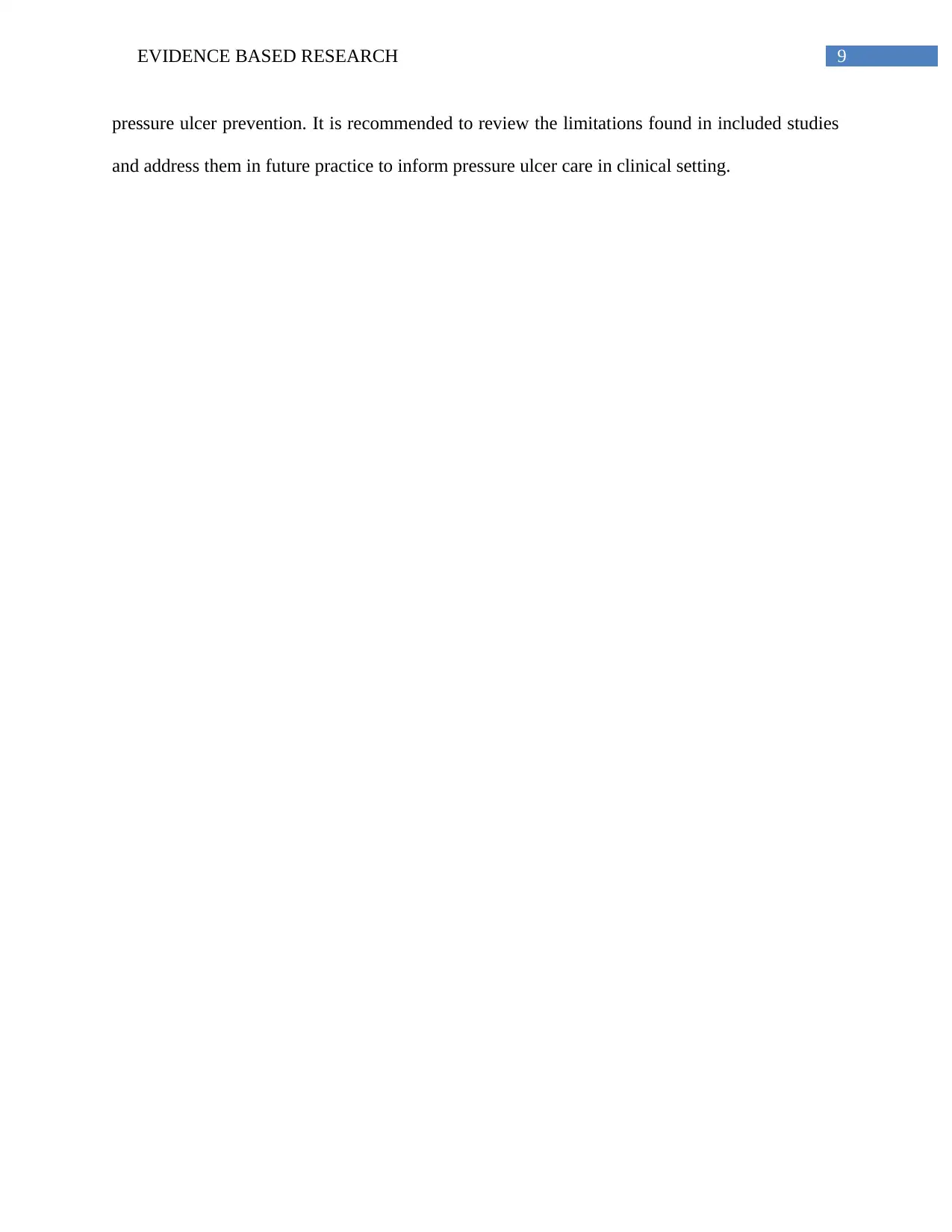
9EVIDENCE BASED RESEARCH
pressure ulcer prevention. It is recommended to review the limitations found in included studies
and address them in future practice to inform pressure ulcer care in clinical setting.
pressure ulcer prevention. It is recommended to review the limitations found in included studies
and address them in future practice to inform pressure ulcer care in clinical setting.
Paraphrase This Document
Need a fresh take? Get an instant paraphrase of this document with our AI Paraphraser
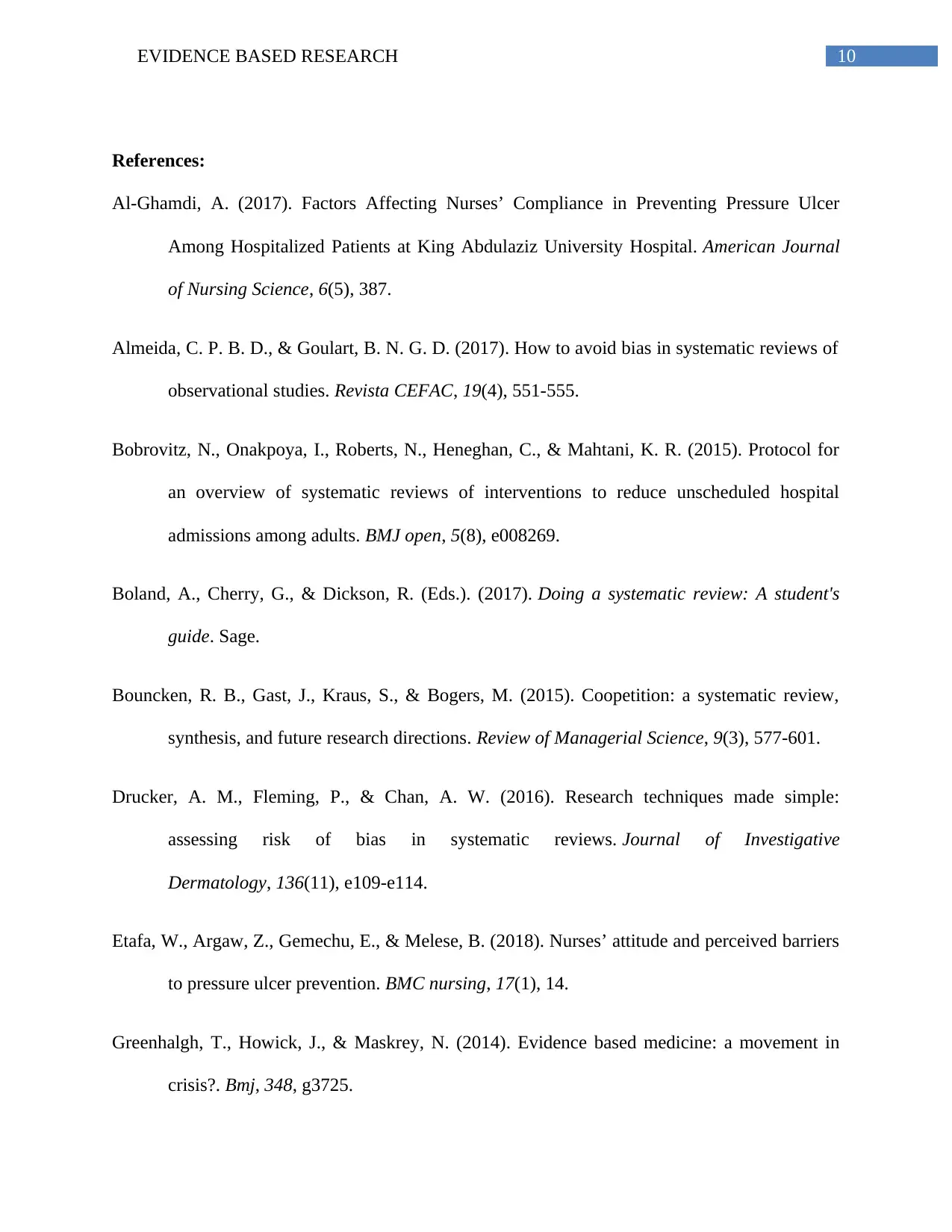
10EVIDENCE BASED RESEARCH
References:
Al-Ghamdi, A. (2017). Factors Affecting Nurses’ Compliance in Preventing Pressure Ulcer
Among Hospitalized Patients at King Abdulaziz University Hospital. American Journal
of Nursing Science, 6(5), 387.
Almeida, C. P. B. D., & Goulart, B. N. G. D. (2017). How to avoid bias in systematic reviews of
observational studies. Revista CEFAC, 19(4), 551-555.
Bobrovitz, N., Onakpoya, I., Roberts, N., Heneghan, C., & Mahtani, K. R. (2015). Protocol for
an overview of systematic reviews of interventions to reduce unscheduled hospital
admissions among adults. BMJ open, 5(8), e008269.
Boland, A., Cherry, G., & Dickson, R. (Eds.). (2017). Doing a systematic review: A student's
guide. Sage.
Bouncken, R. B., Gast, J., Kraus, S., & Bogers, M. (2015). Coopetition: a systematic review,
synthesis, and future research directions. Review of Managerial Science, 9(3), 577-601.
Drucker, A. M., Fleming, P., & Chan, A. W. (2016). Research techniques made simple:
assessing risk of bias in systematic reviews. Journal of Investigative
Dermatology, 136(11), e109-e114.
Etafa, W., Argaw, Z., Gemechu, E., & Melese, B. (2018). Nurses’ attitude and perceived barriers
to pressure ulcer prevention. BMC nursing, 17(1), 14.
Greenhalgh, T., Howick, J., & Maskrey, N. (2014). Evidence based medicine: a movement in
crisis?. Bmj, 348, g3725.
References:
Al-Ghamdi, A. (2017). Factors Affecting Nurses’ Compliance in Preventing Pressure Ulcer
Among Hospitalized Patients at King Abdulaziz University Hospital. American Journal
of Nursing Science, 6(5), 387.
Almeida, C. P. B. D., & Goulart, B. N. G. D. (2017). How to avoid bias in systematic reviews of
observational studies. Revista CEFAC, 19(4), 551-555.
Bobrovitz, N., Onakpoya, I., Roberts, N., Heneghan, C., & Mahtani, K. R. (2015). Protocol for
an overview of systematic reviews of interventions to reduce unscheduled hospital
admissions among adults. BMJ open, 5(8), e008269.
Boland, A., Cherry, G., & Dickson, R. (Eds.). (2017). Doing a systematic review: A student's
guide. Sage.
Bouncken, R. B., Gast, J., Kraus, S., & Bogers, M. (2015). Coopetition: a systematic review,
synthesis, and future research directions. Review of Managerial Science, 9(3), 577-601.
Drucker, A. M., Fleming, P., & Chan, A. W. (2016). Research techniques made simple:
assessing risk of bias in systematic reviews. Journal of Investigative
Dermatology, 136(11), e109-e114.
Etafa, W., Argaw, Z., Gemechu, E., & Melese, B. (2018). Nurses’ attitude and perceived barriers
to pressure ulcer prevention. BMC nursing, 17(1), 14.
Greenhalgh, T., Howick, J., & Maskrey, N. (2014). Evidence based medicine: a movement in
crisis?. Bmj, 348, g3725.
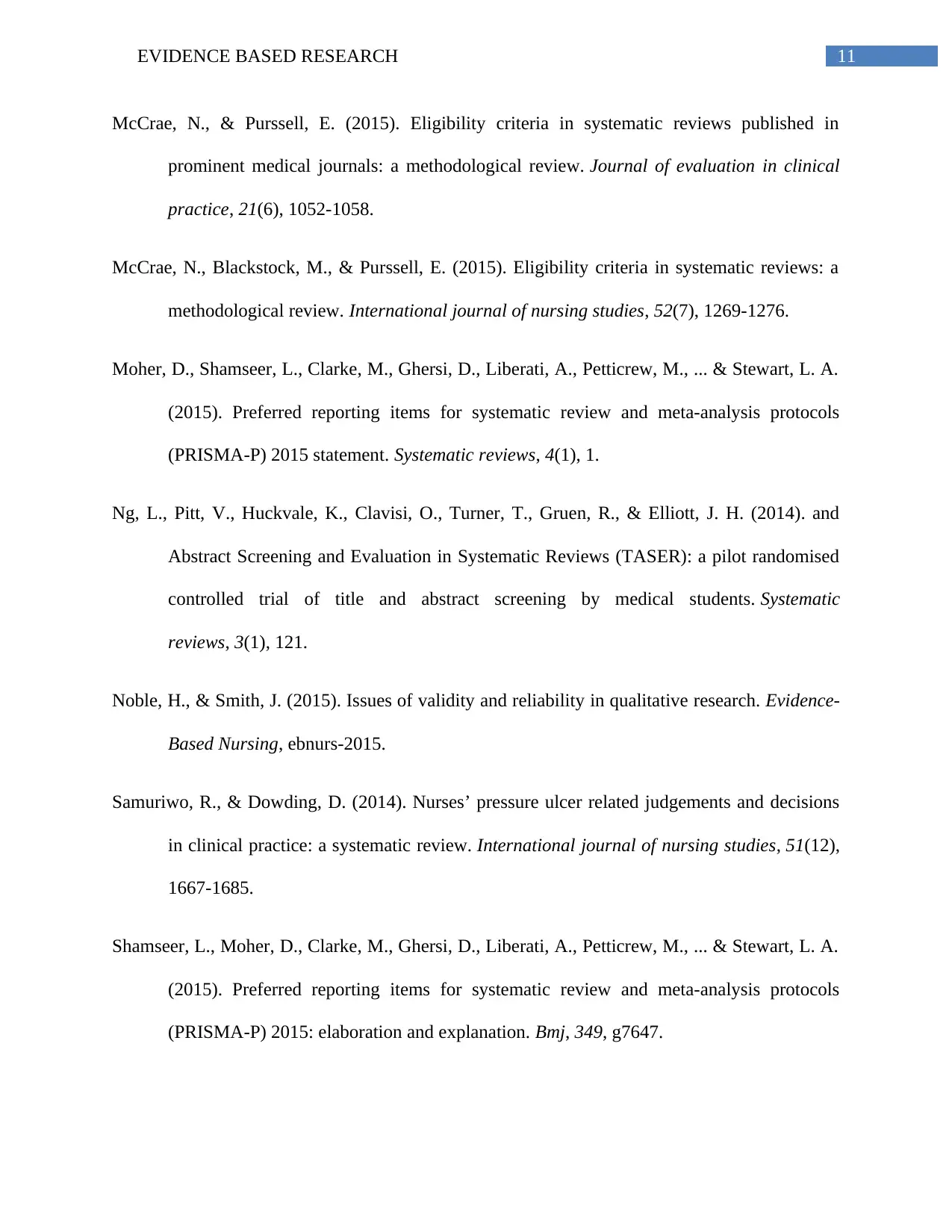
11EVIDENCE BASED RESEARCH
McCrae, N., & Purssell, E. (2015). Eligibility criteria in systematic reviews published in
prominent medical journals: a methodological review. Journal of evaluation in clinical
practice, 21(6), 1052-1058.
McCrae, N., Blackstock, M., & Purssell, E. (2015). Eligibility criteria in systematic reviews: a
methodological review. International journal of nursing studies, 52(7), 1269-1276.
Moher, D., Shamseer, L., Clarke, M., Ghersi, D., Liberati, A., Petticrew, M., ... & Stewart, L. A.
(2015). Preferred reporting items for systematic review and meta-analysis protocols
(PRISMA-P) 2015 statement. Systematic reviews, 4(1), 1.
Ng, L., Pitt, V., Huckvale, K., Clavisi, O., Turner, T., Gruen, R., & Elliott, J. H. (2014). and
Abstract Screening and Evaluation in Systematic Reviews (TASER): a pilot randomised
controlled trial of title and abstract screening by medical students. Systematic
reviews, 3(1), 121.
Noble, H., & Smith, J. (2015). Issues of validity and reliability in qualitative research. Evidence-
Based Nursing, ebnurs-2015.
Samuriwo, R., & Dowding, D. (2014). Nurses’ pressure ulcer related judgements and decisions
in clinical practice: a systematic review. International journal of nursing studies, 51(12),
1667-1685.
Shamseer, L., Moher, D., Clarke, M., Ghersi, D., Liberati, A., Petticrew, M., ... & Stewart, L. A.
(2015). Preferred reporting items for systematic review and meta-analysis protocols
(PRISMA-P) 2015: elaboration and explanation. Bmj, 349, g7647.
McCrae, N., & Purssell, E. (2015). Eligibility criteria in systematic reviews published in
prominent medical journals: a methodological review. Journal of evaluation in clinical
practice, 21(6), 1052-1058.
McCrae, N., Blackstock, M., & Purssell, E. (2015). Eligibility criteria in systematic reviews: a
methodological review. International journal of nursing studies, 52(7), 1269-1276.
Moher, D., Shamseer, L., Clarke, M., Ghersi, D., Liberati, A., Petticrew, M., ... & Stewart, L. A.
(2015). Preferred reporting items for systematic review and meta-analysis protocols
(PRISMA-P) 2015 statement. Systematic reviews, 4(1), 1.
Ng, L., Pitt, V., Huckvale, K., Clavisi, O., Turner, T., Gruen, R., & Elliott, J. H. (2014). and
Abstract Screening and Evaluation in Systematic Reviews (TASER): a pilot randomised
controlled trial of title and abstract screening by medical students. Systematic
reviews, 3(1), 121.
Noble, H., & Smith, J. (2015). Issues of validity and reliability in qualitative research. Evidence-
Based Nursing, ebnurs-2015.
Samuriwo, R., & Dowding, D. (2014). Nurses’ pressure ulcer related judgements and decisions
in clinical practice: a systematic review. International journal of nursing studies, 51(12),
1667-1685.
Shamseer, L., Moher, D., Clarke, M., Ghersi, D., Liberati, A., Petticrew, M., ... & Stewart, L. A.
(2015). Preferred reporting items for systematic review and meta-analysis protocols
(PRISMA-P) 2015: elaboration and explanation. Bmj, 349, g7647.
⊘ This is a preview!⊘
Do you want full access?
Subscribe today to unlock all pages.

Trusted by 1+ million students worldwide
1 out of 13
Related Documents
Your All-in-One AI-Powered Toolkit for Academic Success.
+13062052269
info@desklib.com
Available 24*7 on WhatsApp / Email
![[object Object]](/_next/static/media/star-bottom.7253800d.svg)
Unlock your academic potential
Copyright © 2020–2025 A2Z Services. All Rights Reserved. Developed and managed by ZUCOL.




